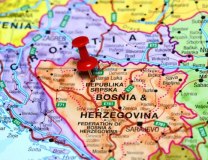"Belgrade Guidelines" for strengthening cooperation
China's Prime Minister Li Keqiang says the Third Meeting of Heads of Government and China and Central and Eastern European Countries (CEECs) will produce the Belgrade Guidelines, which will propose a number of initiatives to strengthen all-round cooperation.
"I am glad to pay an official visit to Serbia and to attend this '16+1' Heads of Government meeting with the 16 leaders from Central and Eastern European countries (CEECs). As I start this heart-warming journey, which brings me back to this enchanting land on the west of the Eurasian continent, I feel I am back among friends and relatives, and I believe much will be accomplished through the visit," Li Keqiang said in an exclusive opinion piece for Tanjug ahead of the summit in Belgrade, and added:
Since the initiation of China-CEEC cooperation three years ago, we have seen closer exchanges and cooperation as well as deepening traditional friendship between China and the 16 countries, which have brought tangible benefits to our peoples and businesses. As a blueprint for cooperation, the Bucharest Guidelines released a year ago identified three major principles and six priority areas for cooperation between China and CEECs. Over the past year, we have implemented the Guidelines in real earnest, turned the blueprint into reality, and secured large numbers of cooperation projects. As many as 69 cooperation initiatives totaling two billion US dollars were reached during the second Local Leaders' Meeting. The People's Bank of China and banks from CEECs agreed on a two billion US dollar investment deal in inter-bank bond market.
Cooperation on nuclear power made breakthrough, and China signed cooperation agreements on quality inspection with a number of CEECs. Investment by Chinese companies in CEECs now exceeds five billion US dollars. The China-CEEC Investment Cooperation Fund, launched less than a year ago, is expected to accomplish 200 million US dollars of investment before the end of the year. Products from CEECs, which were very well received during the CEEC Fair in 2014, are becoming increasingly popular with Chinese consumers.
With profound traditional friendship and no conflict of fundamental interests, China and CEECs are able to respect each other's interests and concerns, and treat each other with sincerity and as equals. When combined, we represent a huge and dynamic market of 1.5 billion people and a ten trillion US dollar economy. We can surely achieve win-win progress, given our similar development levels, strong economic complementarity and broad prospect of cooperation. CEECs have sound economic basis and sufficient human resources, and urgently need more financing to improve and upgrade their infrastructure. China, for its part, has a well-established industrial sector, adequate foreign exchange reserve, and advanced and cost-effective railway, electricity and other equipment manufacturing sectors that are moving into the global market. The two sides may well take infrastructure development as the priority, major-project cooperation as the linchpin, and various forms of investment and financing as the basis to elevate our practical cooperation to a higher level to benefit the people of both sides.
This meeting will release the Belgrade Guidelines, an upgraded version that goes in parallel with the Bucharest Guidelines, and will propose a number of initiatives to strengthen all-round cooperation between China and CEECs. China hopes that it would be an opportunity for the 17 countries to align our respective mid- and long-term development goals and the China-EU 2020 Strategic Agenda for Cooperation, start the formulation of a medium-term agenda for cooperation between China and CEECs, and strengthen coordination to lead our cooperation into the fast track of maturity and progress.
To build a China-Europe land-sea express line has become a highlight for major-project cooperation between China and the 16 CEECs. A convenient and efficient connectivity network that spans across Asia and Europe has always been the dream of countries in this region. The “Belt and Road Initiative” China has proposed aims at working with other countries to make this dream come true. The Northern route, thanks to regular trains between China and Europe, could become a new transport and logistics artery extending to Western Europe through Central and Eastern Europe. Based on the Greek Port of Piraeus and the Railway connecting Belgrade and Budapest, the Southern route could be a China-Europe land-sea express line.
It will significantly enhance regional connectivity, boost the economic development of countries along the route, and provide new and convenient access for Chinese exports to Europe and for European goods to enter China, as it goes through an area that involves 32 million people and 340,000 square kilometers of land. China is ready to work with countries along the routes to actively promote cooperation on facilitating transport, logistics and customs clearance. We welcome the participation of more CEECs in improving and upgrading the connectivity network. The China-Europe land-sea express line, together with regular trains between China and Europe and existing transport and logistics routes, will become an integral, convenient and efficient connectivity network linking Asia with Europe.
Practical cooperation on trade and business still has untapped potential. Trade between China and CEECs has exceeded 50 billion US dollars for three consecutive years, with the growth of China's imports overtaking that of exports by a wide margin. Two-way trade approached 55 billion US dollars in the first 11 months of this year, up by 9 percent year on year, among which China's imports grew much faster than exports. China will continue to import more high-quality products from the 16 CEECs, so as to achieve a dynamic trade balance, and will make best efforts to achieve the 100 billion US dollar annual trade target as early as possible. The Chinese government will encourage competitive Chinese companies to invest in CEECs, and welcomes companies from CEECs to invest in China. China will propose a package of investment and financing framework that allows both Chinese and Central and Eastern European companies to use multiple forms of financing, as they see fit, such as bank loans and investment cooperation funds, to lend financial support to those well-established and major projects between the two sides.
People-to-people exchanges and sub-national cooperation serve to increase friendship and mutual trust, which will in turn foster all-round cooperation. China is ready to step up exchanges with the 16 CEECs on youth, culture, education and other areas, to ensure the success of activities of the 2015 China-CEEC Tourism Cooperation Promotion Year, and to establish a China-CEEC center of scholars and think tanks at an early date. China hopes that visa facilitation could be provided to Chinese visitors. The two sides also need to strengthen cooperation at the local level by incentivizing various regions, provinces/states and cities to cooperate on economy, energy, agriculture and other areas, so as to make the pie of China-CEEC cooperation even bigger. We need to support the work of the Secretariat for Cooperation between China and CEECs, as well as the development of various cooperation associations and other platforms, and encourage the active participation of more groups and individuals who could all contribute to our cooperation.
The international political and economic situation is undergoing profound changes. Recovery of the global economy as a whole remains a difficult process. And countries are faced with the urgent task of developing the economy and improving people's livelihood. In recent years, all-round cooperation between China and Europe has made significant progress, which not only boosted our respective economic development and structural adjustment, but also has become an anchor for world peace and stability. China supports the European integration process, as well as a united, stable and prosperous Europe that plays a greater role in the international community.
The proposed building of the partnerships for peace, growth, reform and civilization by China and the European Union this year injected new vitality to China-EU relations. The comprehensive strategic partnership between China and the European Union now stands at a new historical starting point. China's cooperation with the 16 CEECs will not result in fragmenting the European Union. Much to the contrary, it will help deepen cooperation between China and the European Union and narrow the development gap between the eastern and western parts of the European Union, which may in turn play a part in making the “multi-speed Europe” a less difficult problem. China-CEEC cooperation is undoubtedly part and parcel of China-Europe cooperation, and the two could naturally go in parallel and be mutually reinforcing.
China and the 16 CEECs, though thousands of miles apart, are just like neighbors, because we have built, with our vision and hard work, a bridge of friendship and cooperation across Asia and Europe. This is a bridge for cooperation, a bridge that connects our hearts, and a bridge that serves both us today and our future generations. For “bridge-builders” like us, the biggest source of relief is to see more people and companies of our 17 countries embark on this bridge, which will take them closer to their dreams and accomplish what they want.












